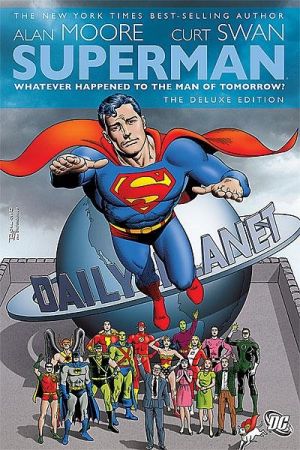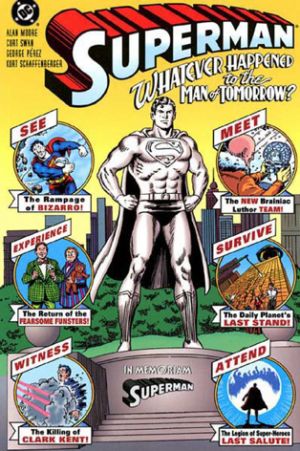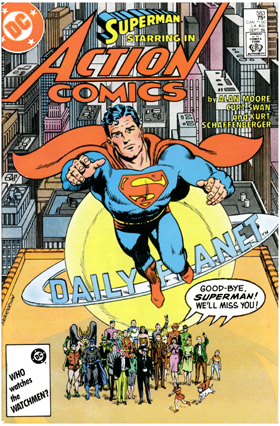- Comics
- Comics Reviews
- Manga
- Comics Reviews
- European Comics
- News
- Comics News
- Press Releases
- Columns
- Spotlight
- Digital Comics
- Webcomics
- Cult Favorite
- Back Issues
- Webcomics
- Movies
- Toys
- Store
- More
- About
By Andy Frisk
February 11, 2010 - 22:58
Originally published in Superman #423 and Action Comics #583 in 1986, the main story reprinted in Superman Whatever Happened to the Man of Tomorrow? The Deluxe Edition, is one of the most highly regarded Alan Moore Superman tales. It is a gripping and gritty tale like many comic book stories were in the days of Frank Miller’s The Dark Knight Returns. What’s particularly interesting about this edition’s title tale (there are two other Alan Moore Superman tales included) is that it is actually the last tale set in the pre-Crisis on Infinite Earths DC Universe. It was meant to be a wrap up and conclusion to the Silver Age Superman character’s story. For an age of rather lighthearted and in some cases silly superhero tales that started in the mid to late 1950’s with the Barry Allen Flash stories and the early Hal Jordan Green Lantern stories, “Whatever Happened to The Man of Tomorrow?” is incredibly dark. It’s a great and touching story, but borders on being almost depressing. Superman meets a noble end, but the way he goes out is a bit harsh and a bit uncharacteristic, if not a little degrading…if you’re not paying attention. A closer look at the tale reveals it to be a Superman story that embodies and reinforces all of the greatness of the character, in a way that only an Alan Moore tale can.
This essay’s look at this particular Superman tale assumes that most of its readers are familiar with the ending to this 20+ year old tale, but if you’re not, be forewarned: there are spoilers ahead. Moore’s story starts with Superman, having mostly silenced his foes, doing deep space research for the US Government. Suddenly, his old foes begin returning and going on uncharacteristically deadly killing sprees. Bizzaro goes on a rampage, killing several residents of Metropolis before taking his own life. The Toyman and The Prankster succeed in revealing that Clark Kent is Superman, and Brainiac takes control of Luthor’s body, thusly merging the two insanely genius intellects into a nearly unstoppable foe. Throughout the tale, Superman wonders why his minor foes like Bizzaro have become murderous monsters. More frighteningly, he wonders what will happen when the real monstrously murderous foes begin to show up.
 |
In the end, the mastermind behind the Superman foes’ new deadly ways is revealed, and he’s not the obvious choice for ultimate Superman villain, but it makes such perfect sense that one can’t imagine he hadn’t been used in this capacity before. Here’s where the brilliance of Moore’s talent for characterization comes in. Mxyzptlk has been, at best, one of those annoyingly amusing Superman foes. In Moore’s hands he becomes the most evil and deadly threat to Superman and our dimension (Mxyzptlk is a sorcerer from The Fifth Dimension-told you he was hokey). The only way for Superman to stop Mxyzptlk is to kill him, which he does, with the help of a suggestion from The Legion of Superheroes and Mxyzptlk’s own self preserving actions. He’s ripped in two as Superman attempts to capture him in The Phantom Zone’s ray as he tries to escape back to The Fifth Dimension by saying his own name backwards (Kltpzyxm). Superman, breaking his own golden rule by taking a life, then walks into a chamber of Gold Kryptonite (which will take away his powers) and walks out of The Fortress of Solitude to his death…
The whole story of Superman’s last days is being told by Lois to a reporter from The Daily Planet (from which she has long since retired from) for the Planet’s Superman Memorial Edition, hence it’s all a flashback, but most importantly, it’s all Lois’ version of the story. There are no other witnesses to the final events of Superman’s life, and The Planet reporter has no reason to doubt Lois’ honesty. Surely she’s telling the truth, and she is except for one crucial fact. Superman did not die powerless in the Arctic wastes. When Lois’ husband Jordy shows up, who looks a lot like a certain superhero (minus the reddish/salt and pepper hair and mustache), we realize that Superman didn’t break his rule again and take a life twice. Superman kills Mxyzptlk in order to save the universe, and then seemingly commits suicide, but instead lives a normal life with the love of his life, taking on his father’s name (Jordy could be a bastardization of Jor-El) and naming his and Lois’ son after his human dad, Jonathan. It’s a neat happy ending to the Man of Steel’s story. What makes this unique Superman tale so interesting is its blatant humanism. Lois has lied to the world for at least a decade. Superman has lived a new life right under everyone’s noses, and even more surprisingly, enjoys not being a hero and not saving the world. He’s given it all up to be with Lois, with no regrets. In the end Superman was able to walk away from it all and not look back. Superman had been a larger than life character, throughout the Silver Age especially. His morals were always as super as super strength. In Alan Moore’s hands though, Superman becomes just like the overwhelming majority of men. He demonstrates uncharacteristic realism instead of his trademark idealism. Or does he simply allow himself to become human in spirit then have to allow himself to become human physically? Superman metaphorically is never truly human as long as he lives by his code of high morality, and once he breaks his code, he can no longer be Superman. Moore then is not simply humanizing the character and spirit of Superman. He’s honoring it at the highest level. A Superman who kills is no Superman, and even Superman himself realizes this.
 |
Yes, the Silver Age Superman was a larger than life character; he was supremely powerful, morally unambiguous, and honestly quite boring. When John Byrne re-launched Superman with his post Crisis miniseries, The Man of Steel, Superman was a much more human character, and while definitely not immoral or amoral by any stretch of the imagination, he did face moral challenges and ambiguities much more in tune with what an everyday mortal man would. Some years on, Moore’s theme of a “Superman who kills is no Superman” would be tackled by other writers at DC Comics. Superman would exile himself from Earth this time instead of giving up his powers. The Silver Age Superman character’s final appearance and actions in Moore’s story therefore foreshadowed the changes and the new direction Byrne and company were to shortly bring to the Superman character. Superman would become more human. Moore, along with Miller and a few select others, can be defined as the fathers of modern comics, but could Moore also be one of the spiritual fathers of the modern Superman? Perhaps, this assertion is taking the influence of Moore’s Superman too far, as “Whatever Happened to the Man of Tomorrow” could simply be a product of the realism movement afoot in comics in the mid to late 1980’s, but it’s an interesting idea.
“Whatever Happened to The Man of Tomorrow” has recently been republished in hardback with a few other tales in which Superman appears, as mentioned earlier. Issue #85 of DC Comics Presents which was originally published in September of 1985 and Superman Annual #11 also from 1985, are collected with the title tale. This deluxe edition hardcover is oversized and printed on thick paper so it really does justice to the fantastic artwork of Curt Swan and Dave Gibbons, in particular. Curt Swan’s work on Superman #423 and Action Comics #583 is characteristically strong. His iconic pencils and depiction of Superman defines the character’s look for its time period. Very clean art, with perfect anatomy and sharp backgrounds are the hallmarks of Swan’s work, and they are on vivid display in this classic tale.
 |
Superman: Whatever Happened to The Man of Tomorrow? Deluxe Edition truly could have been titled The Alan Moore Superman, but with the recent “death” of Bruce Wayne and the subsequent publication of Batman: Whatever Happened to The Caped Crusader? Deluxe Edition featuring Neil Gaiman’s Batman stories, including the edition’s title story originally printed in Batman #685 and Detective Comics #852, the Superman edition and Batman editions are meant to be companion pieces. The Batman edition could also easily have been titled The Neil Gaiman Batman after its author. Gaiman himself is an industry legend, but an examination of his Batman farewell tale is a topic for another time…
Rating: 10 /10